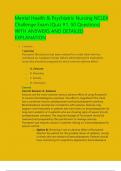Exam (elaborations)
Mental Health & Psychiatric Nursing NCLEX Challenge Exam (Quiz #1: 50 Questions) WITH ANSWERS AND DETAILED EXPLANATION
- Course
- Institution
Title: Mental Health & Psychiatric Nursing ATI NCLEX Challenge Exam (Quiz #1: 50 Questions) WITH ANSWERS AND DETAILED EXPLANATION Description: Prepare for success in your mental health and psychiatric nursing exams with our comprehensive ATI NCLEX Challenge Exam (Quiz #1: 50 Questions) package,...
[Show more]



